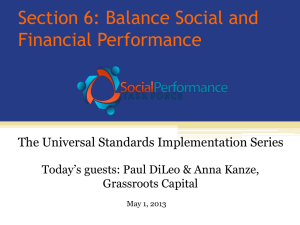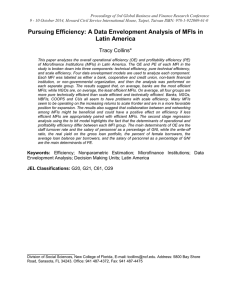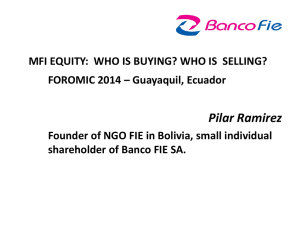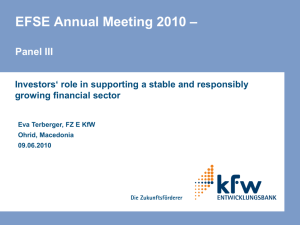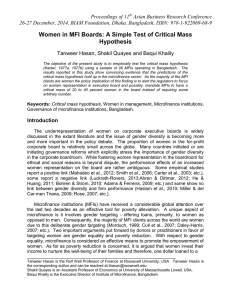Section 6: Balance Social and Financial Performance
advertisement
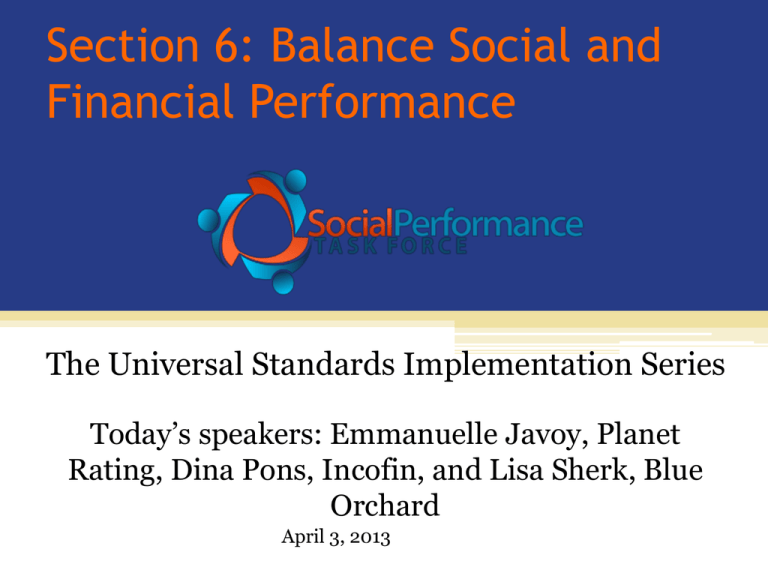
Section 6: Balance Social and Financial Performance The Universal Standards Implementation Series Today’s speakers: Emmanuelle Javoy, Planet Rating, Dina Pons, Incofin, and Lisa Sherk, Blue Orchard April 3, 2013 Agenda • Review of Section 6 of the Universal Standards • Interview with Dina Pons from Incofin • Interview with Emmanuelle Javoy from Planet Rating • Update from Lisa Sherk on the AVOID Working Group • Discussion with Participants Section 6 of the Universal Standards • Section Title: Balance Social and Financial Performance • Rationale: An institution’s financial decisions and results should reflect their social goals. • Four standards: ▫ ▫ ▫ ▫ 6a- Growth 6b- Financing structure & profits 6c- Prices & profits 6d- Executive compensation 6a- Growth rates are sustainable and appropriate for market conditions, allowing for high service quality. Essential Practices • Set sustainable target growth rates, considering both internal factors (e.g., staffing, information systems, financing) and external factors (e.g., competition, market saturation, client over-indebtedness). • Manage the risks associated with growth by: 1) assessing market conditions to ensure that neither sustainability nor client wellbeing are compromised by pursuit of short-term growth, and 2) setting and verifying compliance with growth related policies across all departments/branches. • Examine quarterly growth rates for all branches/regions, not just the overall annual rates and use a monitoring system to identify unexpected and unsanctioned growth. • Monitor whether internal capacity (e.g., MIS, risk management, employee training) is keeping pace with institutional growth in number of clients and amount of loans and deposits, and increase that capacity as 6b- The institution’s financing structure is appropriate to a double bottom line institution in its mix of sources, terms, and desired returns. Essential Practices • Ensure alignment with investors on 1) the use of the institution’s returns, and 2) the profitability expectations of the institution. • Ensure alignment with investors on planned time horizons for investment, and exit strategies are aligned with the institution’s social goals and stage of development. • Consider the total cost of capital when deciding on a financing structure in order to understand what cost would be passed on to the client. • Protect client savings and cash collateral. • Invest a portion of profits to increase value to customers, such as lowering interest rates or adding or improving products and services. 6c- Pursuit of profits does not undermine the longterm sustainability of the institution or client wellbeing. Essential Practices • Set responsible prices for products and services (e.g., effective interest rates on loans, fees for remittances, insurance premiums), meaning that prices are: • Market-oriented and competitive within the country context; and • Allow the institution to earn a rate of return to support operations and grow • The Board monitors whether the institution’s pricing levels for all products and services are consistent with the institution’s policies on returns. • Establish a loan-officer-to-client ratio that promotes high service quality for clients. 6d- The institution offers compensation to senior managers that is appropriate to a double bottom line institution. Essential Practices • Transparently disclose compensation (defined as salary, benefits, bonuses, stock options, and cash value of perquisites) to regulators, donors, and investors, upon request. • Calculate the difference between the average compensation of top level executives (e.g., CEO, CFO) and field employees, and evaluate whether this spread is consistent with the institution’s mission, social goals, and commitment to treat employees responsibly. Interview with Dina Pons, Incofin Standard 6a- Growth rates are sustainable and appropriate for market conditions, allowing for high service quality. How does Incofin look for when assessing an FI’s growth rates? • First level of analysis: • Level of microfinance services penetration in the country/provinces/districts of where the MFI is located. • Level of multiple borrowing, presence of a credit bureau, etc. • Level of growth rates and type of product offering, average loan size of the main microfinance providers. • Second level analysis: • Past and present levels of growth rates of the MFI. • Projected growth rates of the MFI (conversation with MT and BOD). • Third level analysis: • Refined analysis per branch, per quarter, per region, etc • Analysis of internal capacities (MIS, risk management, credit underwriting policies, delinquency management, etc). • Analysis of HR: middle managers, compliance culture, incentive schemes, etc. When assessing an investee’s growth rates, what do you consider “responsible” vs. “irresponsible? • Due diligence tool rewards average annual growth rates standing between 25% to 75% depending on the factors previously described. ▫ Start-up MFIs in virgin markets with growth rates at 150% ▫ Mature MFIs in highly penetrated markets with growth rates at 25% ▫ Young and fragile MFIs with limited internal capacities in low penetrated market with growth rates at 45%. • Responsible growth rate analysis cannot be captured by one ratio, but shall take into account several factors. • Need for consolidated data and country level analysis for investors to use as reference grid ? (Mimosa, OID studies, etc). Do investors have a responsibility to assess market penetration when making investment decisions? • For each individual investment: ▫ There is a responsibility to assess market penetration before investing. ▫ For debt investments: there is a responsibility to monitor and discuss market penetration with the management team during the investment ▫ For equity investments: there is a responsibility to set reasonable growth rates at the BOD level and in agreement with the whole operation staff and management. • For markets as a whole: ▫ There is a responsibility to assess market penetration before investing. ▫ Need for collaborative work among investors (Kyrgyzstan group, AVOID, OID study) ▫ Example of the OID study conducted in Cambodia. Co-financed by Blue Orchard, Incofin IM, Oikocredit Cooperation of 8 leading Cambodian MFIs Publication date : April 5th Interview with Emmanuelle Javoy, Planet Rating Standard 6a- Growth rates are sustainable and appropriate for market conditions, allowing for high service quality. When rating an FI, which growthrelated factors do you assess? • Quality of the assessment by the MFI of the capacity of its market • Internal capacity to manage the training of staff • MIS that can adapt • Internal audit function that can keep up with growth. Audit plan that oversamples new branches • Performance analysis that takes into account the fact that PAR is not an efficient measure of portfolio quality when the proportion of “fresh” portfolio is important > analysis by vintages of portfolio needed What problems have you seen at the market level, caused by irresponsible growth rates? • In markets where growth rates are either not adapted to the market capacity or to the internal capacity of MFIs, we usually see the development of unhealthy competition (poaching of staff with their portfolio of clients) or marketing techniques (aggressive sales techniques, offer to buy-out existing loans) which can create a downward spiral for all actors What is MIMOSA and how will it help the industry understand and prevent irresponsible growth and client over-indebtedness? • MIMOSA is a model to estimate the credit market capacity • It is based on data from Global Findex • Analysis shows that the use of credit for formal financial institutions is correlated to ▫ HDI (Human Development Index) ▫ Savings at formal financial institutions ▫ Use of semi-formal borrowing sources (employer, private lender, etc.) • We assign a score to each market based on the comparison between the predicted credit market capacity and the current use of credit. • A score of 5 identifies countries where the current use of credit is at least twice the predicted level MIMOSA Market Score 1 5 Update from the Avoiding OverIndebtedness Working Group Discussion with Participants Where to find resources • SPM Resource Library for the Universal Standards: http://sptf.info/spmstandards/standardsimplementation-resources • This presentation and audio recording: http://sptf.info/online-trainings/universalstandards-implementation
